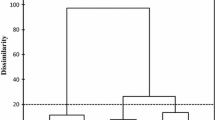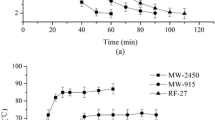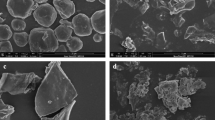Abstract
Microwave treatment is a new method for rapeseed processing. To better understand the benefits of microwave pretreatment on rapeseed processing, qualitative and quantitative analysis of sinapic acid derivatives is needed. In this study, the effect of microwave treatment on the content of sinapic acid derivatives in rapeseed and the effect of cold-press and solvent extraction on the content of sinapic acid derivatives in rapeseed meal were evaluated using ultrahigh pressure liquid chromatography. It was found that during the microwave treatment, the content of sinapine and sinapic acid in the rapeseed increased slightly at the outset of treatment and significantly decreased thereafter. Following 7 min of microwave treatment, the content of sinapine in rapeseed exhibited its largest decrease of 16.7 %. By contrast, microwave heating of the rapeseed increased the canolol content significantly. We employed two sample paired t tests as a means to analyze the difference between meal and defatted cold-pressed cake. The results indicated that the content of sinapine and sinapic acid in defatted cake was significantly higher than that in meal, while the different extraction methods (solvent extraction and cold-press) did not appear to have a significant influence on the content of canolol in meal (p ≤ 0.05).





Similar content being viewed by others
References
Azadmard-Damirchi S, Habibi-Nodeh F, Hesari J, Nemati M, Achachlouei BF (2010) Effect of pretreatment with microwaves on oxidative stability and nutraceuticals content of oil from rapeseed. Food Chem 121:1211–1215
Spielmeyer A, Wagner A, Jahreis G (2009) Influence of thermal treatment of rapeseed on the canolol content. Food Chem 112:944–948
Krygier K, Sosulski F, Hogge L (1982) Free, esterified and insoluble-bound phenolic acids. 1. Extraction and purification procedure. J Agri Food Chem 30:330–334
Milkowski C, Strack D (2010) Sinapate esters in brassicaceous plants: biochemistry, molecular biology, evolution and metabolic engineering. Planta 232:19–35
Brettonnet A, Hewavitarana A, DeJong S, Lanari MC (2010) Phenolic acids composition and antioxidant activity of canola extracts in cooked beef, chicken and pork. Food Chem 121:27–933
Koski A, Pekkarinen S, Hopia A, Wähälä K, Heinonen M (2003) Processing of rapeseed oil: effects on sinapic acid derivative content and oxidative stability. Eur Food Res Technol 217:110–114
Terpinc P, Polak T, Šegatin N, Hanzlowsky A, Ulrih NP, Abramovic H (2011) Antioxidant properties of 4-vinyl derivatives of hydroxycinnamic acids. Food Chem 128:62–69
Lacki K, Duvnjak Z (1999) A method for the decrease of phenolic content in commercial canola meal using an enzyme preparation secreted by the white-rot fungus trametes versicolor. Biotechnol Bioeng 62:422–433
Khattab R, Eskin M, Aliani M, Thiyam U (2010) Determination of sinapic acid derivatives in canola extracts using high-performance liquid chromatography. J Am Oil Chem Soc 87:147–155
Zhou H, Huang Y, Hoshi T, Kashiwagi Y, Anzai J, Li G (2005) Electrochemistry of sinapine and its detection in medicinal plants. Anal Bioanal Chem 382:1196–1201
Cai R, Arntfielda SD (2001) A rapid high-performance liquid chromatographic method for the determination of sinapine and sinapic acid in canola seed and meal. J Am Oil Chem Soc 78(9):903–910
Hayat K, Zhang X, Farooq U, Abbas S, Xia S, Jia C, Zhong F, Zhang J (2010) Effect of microwave treatment on phenolic content and antioxidant activity of citrus mandarin pomace. Food Chem 123:423–429
Fenwick GR, Spinks EA, Wilkinson AP, Heaney RK, Legoy MA (1986) Effect of processing on the antinutrient content of rapeseed. J Sci Food Agri 37(8):735–741
Szydlowska-Czerniak A, Trokowski K, Karlovits G, Szlyk E (2010) Determination of antioxidant capacity, phenolic acids, and fatty acid composition of rapeseed varieties. J Agric Food Chem 58:7502–7509
Bhinu VS, Schafer UA, Li R, Huang J, Hannoufa A (2009) Targeted modulation of sinapine biosynthesis pathway for seed quality improvement in Brassica napus. Transgenic Res 18:31–44
Naczk M, Amarowicz R, Sullivan A, Shahidi F (1988) Current research developments on polyphenolics of rapeseed/canola: a review. Food Chem 62(4):489–502
Cerretani L, Bendini A, Rodriguez-Estrada MT, Vittadini E, Chiavaro E (2009) Microwave heating of different commercial categories of olive oil: part I. Effect on chemical oxidative stability indices and phenolic compounds. Food Chem 115:1381–1388
Liazid A, Palma M, Brigui J, Barroso CG (2007) Investigation on phenolic compounds stability during microwave-assisted extraction. J Chromatogr A 1140:29–34
Gutfinger T (1981) Polyphenols in olive oils. J Am Oil Chem Soc 58(11):966–968
Acknowledgments
This work was supported by National Natural Science Foundation of China (31071637) and the earmarked fund for Modern Agro-industry Technology Research System.
Author information
Authors and Affiliations
Corresponding author
About this article
Cite this article
Niu, Y., Jiang, M., Wan, C. et al. Effect of Microwave Treatment on Sinapic Acid Derivatives in Rapeseed and Rapeseed Meal. J Am Oil Chem Soc 90, 307–313 (2013). https://doi.org/10.1007/s11746-012-2167-y
Received:
Revised:
Accepted:
Published:
Issue Date:
DOI: https://doi.org/10.1007/s11746-012-2167-y




